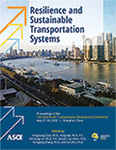13th Asia Pacific Transportation Development Conference
Warrants and Recommendations on Using Temporary Work Zone Signs in High Wind Areas
Publication: Resilience and Sustainable Transportation Systems
ABSTRACT
Under high wind, temporary traffic signs in a work zone are possibly being knocked down, which is a safety threat to through traffic, and is one of major contributors of work zone related incidents. In this paper, traffic engineers’ opinions in the performance and application of mostly used temporary traffic signs were collected, followed by the field observations in the state of Texas, USA, and wind effect simulation on temporary traffic signs through finite element analysis. Previous cost-benefit analyses of temporary sign applications were reviewed, and warrants of the applications in work zones with high wind were recommended. Field observations suggest that, embedding signs performed better than skid signs in work zones when high winds are in presence. For the finite element analysis, four important factors were employed to evaluate the performance of each temporary sign, such as: (1) minimum safety factor, (2) maximum stress distribution, (3) maximum displacement, and (4) deviation angle. It was concluded that, for areas with strongly higher wind, the embedding traffic signs are mandatorily recommended like the dual leg perforated square metal tubing with anchor sign and its updated versions, while skid signs are not recommended. In areas with moderate strong wind during certain specific months, the embedding signs are highly recommended, while skid signs shall be limited for use, including: (a) the independent dual upright with leg PSST skid sign, and (b) the dual leg PSST skid support sign. For light wind area and relevant time periods, both embedding signs and skid signs can be safely used. Wooden signs, such as the wooden skid with two wooden legs sign, and wooden long/intermediate-term single leg (H-leg) sign, are also alternative options.
Get full access to this article
View all available purchase options and get full access to this chapter.
ACKNOWLEDGEMENT
This paper is sponsored in part by the Texas Department of Transportation research project 0-6993. The authors are very grateful to project manager Joanne Steele, all members of project management committee, Mr. Abayomi Bakare, Mr. Francis Foyeku, and many other personnel for their supports or responding to the engineer survey.
REFERENCES
CTDOT (2017). Connecticut highway safety improvement program 2017 report.
CUTR (2007). Enhancing traffic signs to resist hurricane-force winds. University of South Florida Center for Urban Transportation Research
NBC (2019). Replacing and repairing road signs after Hurricane Michael. NBC News. URL: https://www.wjhg.com/content/news/Replacing-and-repairing-road-signs-after-Hurricane-Michael-507757981.html.
NHTSA (2015). Traffic safety facts crash. National Center for Statistics and Analysis.
Patrick, R. & Seth, S. (2017). Hurricane Irma: Inoperable traffic lights are four-way stops. Naples Daily News. URL: https://www.naplesnews.com/story/weather/hurricanes/2017/09/13/hurricane-irma-inoperable-traffic-lights-four-way-stops/662150001/.
Scruton, C. (1963). “On the wind excited oscillations of stacks, towers and masts.” Proc. Int. Conf. Wind Effects on Buildings and Structures, 1963. 798-833.
Toy, N., Savory, E. & Akintaro, S. (1996). “Wind loads on perforated flat plate temporary road signs.” Proceedings of the BBAA3 Conference, Blacksburg, VA, USA.
TxDOT (2016). Texas motor vehicle crash statistics - 2016. Texas Department of Transportation
USDOT (2019). Manual on uniform traffic control devices. Federal Highway Administration.
Weatherford, J. S. (2008). Hurricane Ike traffic signal preparation & recovery. Department of Public Works and Engineering.
WSDOT (2015). WSDOT traffic manual. Washington Department of Transportation.
Information & Authors
Information
Published In
Resilience and Sustainable Transportation Systems
Pages: 186 - 195
Editors: Fengxiang Qiao, Ph.D., Texas Southern University, Yong Bai, Ph.D., Marquette University, Pei-Sung Lin, Ph.D., University of South Florida, Steven I Jy Chien, Ph.D., New Jersey Institute of Technology, Yongping Zhang, Ph.D., California State Polytechnic University, and Lin Zhu, Ph.D., Shanghai University of Engineering Science
ISBN (Online): 978-0-7844-8290-2
Copyright
© 2020 American Society of Civil Engineers.
History
Published online: Jun 29, 2020
Published in print: Jun 29, 2020
Authors
Metrics & Citations
Metrics
Citations
Download citation
If you have the appropriate software installed, you can download article citation data to the citation manager of your choice. Simply select your manager software from the list below and click Download.
